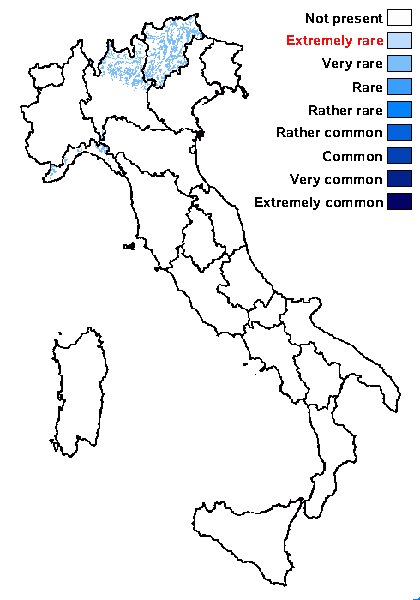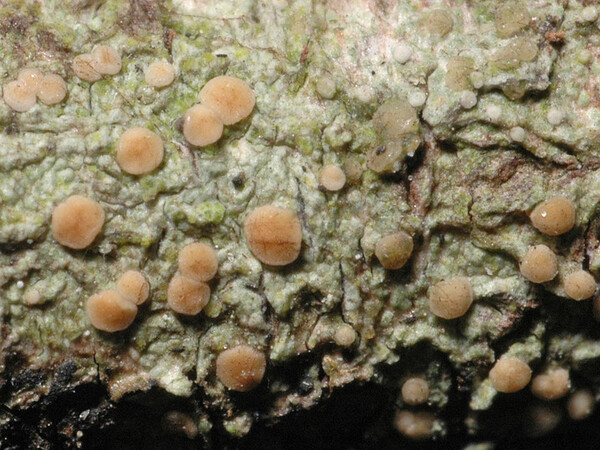Biatora meiocarpa (Nyl.) Arnold
Verh. zool.-bot. Ges. Wien, 37: 141, 1887. Basionym: Lecidea meiocarpa Nyl. - Flora, 59: 577, 1876.
Synonyms: Biatora meiocarpa (Nyl.) Arnold; Lecidea meiocarpa Nyl.; Lecidea minuta auct. non (Nyl.) Nyl.
Distribution: N - TAA (Nascimbene & al. 2022), Lomb, Lig.
Description: Thallus crustose, rimose-areolate or small-areolate, sometimes partly endosubstratic, pale beige to greyish green. Apothecia biatorine, rounded to rarely deformed-tuberculate, sessile and constricted at base, 0.45-0.6 mm across, with an orange brown to brown, epruinose, flat to slightly convex disc, and a thin, usually paler, sometimes indistinct, finally excluded proper margin. Proper exciple colourless throughout to orange-brown in innermost part, laterally 30-75 µm wide, of radiating hyphae with 1.5-3.5 µm thick lumina, the apical cells 2-6 µm wide; epithecium scarcely differentiated from the hymenium, colourless or rarely with orange-brown droplets; hymenium colourless to pale golden brown, 40-55 µm high; paraphyses simple or weakly branched and anastomosing, 0.7-1.2 µm thick at mid-level, the apical cells 1.5-4 µm wide; subhymenium distinct, 20-60 µm high; hypothecium colourless, 35-120 µm high. Asci 8-spored, clavate, with a K/I+ blue apical dome penetrated by a narrow, K/I- apical cushion surrounded by a narrow, deeply K/I+ blue zone, the wall K/I- but surrounded by an I+ red-brown, K/I+ blue outer layer, the ocular chamber relatively small, Biatora-type. Ascospores 1-celled (rarely a few 1-septate), hyaline, (7.5-)10-15(-17) x 3-4(-5) µm. Pycnidia globular, semi-immersed, c. 100 µm in diam., the wall colourless to pale brown. Conidia broadly filiform, 25-35(-45) x 1-1.8 µm. Photobiont chlorococcoid. Spot tests: thallus K-, C-, KC-, P-. Chemistry: without lichen substances.Note: Ekman (1994) states that this is a northern species, confined to Fennoscandia; reports from central Europe could be due to misidentifications, perhaps with the similar B. helvola, with Lecania cyrtellina, or with epiphytic samples of B. subduplex. All Italian records (see Nimis 1993: 386) should be checked.
Growth form: Crustose
Substrata: bark
Photobiont: green algae other than Trentepohlia
Reproductive strategy: mainly sexual
Commonnes-rarity: (info)
Alpine belt: absent
Subalpine belt: absent
Oromediterranean belt: absent
Montane belt: very rare
Submediterranean belt: absent
Padanian area: absent
Humid submediterranean belt: absent
Humid mediterranean belt: absent
Dry mediterranean belt: absent

Predictive model
Growth form: Crustose
Substrata: bark
Photobiont: green algae other than Trentepohlia
Reproductive strategy: mainly sexual
Commonnes-rarity: (info)
Alpine belt: absent
Subalpine belt: absent
Oromediterranean belt: absent
Montane belt: very rare
Submediterranean belt: absent
Padanian area: absent
Humid submediterranean belt: absent
Humid mediterranean belt: absent
Dry mediterranean belt: absent

Predictive model
 INDEX FUNGORUM
INDEX FUNGORUM
 GBIF
GBIF
 DOLICHENS
DOLICHENS


